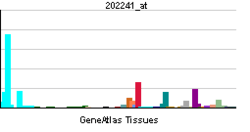TRIB1
Tribbles homolog 1 is a protein that in humans is encoded by the TRIB1 gene.[1][2][3] Orthologs of this pseudokinase protein can be found almost ubiquitously throughout the animal kingdom. It enacts its function through binding to signalling proteins of the MAPKK level of the MAPK pathway, therefore eliciting a regulatory role in the function of this pathway which mediates proliferation, apoptosis and differentiation in cells. Tribbles-1 is encoded by the trib1 gene, which in humans can be found on chromosome 8 at position 24.13 on the longest arm (q).
Function
Tribbles-1 is one of three members of the Tribbles subfamily, which is a part of the CAMK Ser/Thr protein kinase family, of the protein kinase superfamily. The Tribbles subfamily is one of the pseudokinases, meaning that while expressing putative kinase regions in its structure, it is non-catalytic. The Tribbles subfamily lacks a functional ATP binding pocket, and therefore cannot phosphorylate its substrates; instead, Tribbles proteins function as scaffold proteins, which bind their substrates to localize them to or from their function.
Expression of Tribbles-1 is highly variable, constantly changing with respect to time and cell-type,[4] which suggests a large amount of regulation that exists in the cell. The protein's primary structure contains a PEST region, indicative of proteins that are highly susceptible to degradation in the cell; Tribbles-1 plays a role in regulating its own expression by binding to its substrate, which not only produces its function on the MAPK pathway, but also works to protect it from degradation whilst binding. This, in part, creates a positive feedback loop in the function of Tribbles-1, as the function of Tribbles-1 directly aids in the increase of the amount of it. As positive feedback loops are often seen throughout biology in circumstances that require the alleviation of an external stimulus, the positive feedback loop exhibited by Tribbles-1 suggests that it plays a functional role in cell response.
Clinical significance
Tribbles-1 is an inflammatory regulator.
Tribbles-1 is associated with Acute Myeloid Leukemia (AML).
Tribbles-1 has been implicated in atherosclerosis.
References
- ↑ Wilkin F, Suarez-Huerta N, Robaye B, Peetermans J, Libert F, Dumont JE, Maenhaut C (Nov 1997). "Characterization of a phosphoprotein whose mRNA is regulated by the mitogenic pathways in dog thyroid cells". Eur J Biochem 248 (3): 660–68. doi:10.1111/j.1432-1033.1997.t01-1-00660.x. PMID 9342215.
- ↑ Hegedus Z, Czibula A, Kiss-Toth E (Aug 2006). "Tribbles: novel regulators of cell function; evolutionary aspects". Cell Mol Life Sci 63 (14): 1632–41. doi:10.1007/s00018-006-6007-9. PMID 16715410.
- ↑ "Entrez Gene: TRIB1 tribbles homolog 1 (Drosophila)".
- ↑ Sung HY, Francis SE, Crossman DC, Kiss-Toth E (Apr 2006). "Regulation of expression and signalling modulator function of mammalian tribbles is cell-type specific". Immunology Lett. 104 (1-2): 171–177. doi:10.1016/j.imlet.2005.11.010. PMID 16364454.
Further reading
- Tang K, Finley RL, Nie D, Honn KV; Finley (2000). "Identification of 12-lipoxygenase interaction with cellular proteins by yeast two-hybrid screening". Biochemistry 39 (12): 3185–91. doi:10.1021/bi992664v. PMID 10727209.
- Wu M, Xu LG, Zhai Z, Shu HB (2003). "SINK is a p65-interacting negative regulator of NF-kappaB-dependent transcription". J. Biol. Chem. 278 (29): 27072–9. doi:10.1074/jbc.M209814200. PMID 12736262.
- Kiss-Toth E, Bagstaff SM, Sung HY et al. (2004). "Human tribbles, a protein family controlling mitogen-activated protein kinase cascades". J. Biol. Chem. 279 (41): 42703–8. doi:10.1074/jbc.M407732200. PMID 15299019.
- Xu C, Zhang J, Huang X et al. (2006). "Solution structure of human peptidyl prolyl isomerase-like protein 1 and insights into its interaction with SKIP". J. Biol. Chem. 281 (23): 15900–8. doi:10.1074/jbc.M511155200. PMID 16595688.
- Sung HY, Guan H, Czibula A et al. (2007). "Human Tribbles-1 Controls Proliferation and Chemotaxis of Smooth Muscle Cells via MAPK Signalling Pathways". J. Biol. Chem. 282 (25): 18379–87. doi:10.1074/jbc.M610792200. PMC 2366084. PMID 17452330.
External links
- TRIB1 human gene location in the UCSC Genome Browser.
- TRIB1 human gene details in the UCSC Genome Browser.
| |||||||||||||||||||||||||||||||||||||||||||||||||||||||||||||||||||||||||||||||||||||||||||||||||||||||||||||||||||||||||||||||||||||||||||||||||||||||||||||||||
